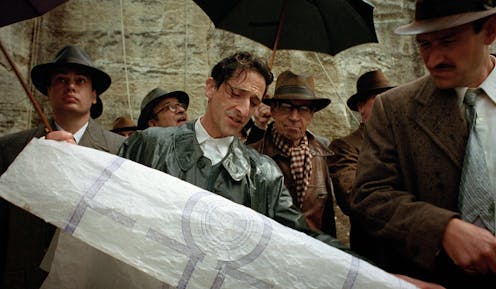
Editors deployed AI to make the Hungarian dialogue in ‘The Brutalist’ sound more authentic. A24/TNS
The 2025 slate of Oscar nominees recognizes many writers, directors and actors whose scripts and performances don’t necessarily reflect their own cultural and linguistic backgrounds.
Greg Kwedar and Clint Bentley, both white, co-wrote “Sing Sing,” a story about rehabilitation through art in a maximum security prison where the characters are almost entirely people of color.
Meg LeFauve has now earned her second nomination for penning a script that gives voice the gamut of emotions surging through a young girl in “Inside Out 2.” She’s in her 50s.
The director of “Conclave,” Edward Berger, its writer, Peter Straughan, and its lead actor, Ralph Fiennes, are all self-proclaimed lapsed Catholics. Yet they brought to life a political thriller set in the Vatican.
“The Brutalist” was written entirely in English, but much of the film’s dialogue is in Hungarian, with two leads who are not native Hungarian speakers.
Most screenwriters endeavor to craft characters outside their own backgrounds and experiences. But concerns about authentic language representation and cultural accuracy persist, and accusations of cultural appropriation and lazy research are commonplace.
“Emilia Pérez,” for example, has been heavily criticized not only for unrealistic portrayals of gender transition but also for inauthentic depictions of Mexican culture and accents.
The film’s director, Jacques Audiard, has even claimed his lack of knowledge of Spanish has been an artistic benefit. He says it gives him “a quality of detachment” to emphasize “emotion” rather than “focus too strongly on the accent, the punctuation.”
His lack of interest in precise depictions of language and culture contrasts sharply with our recent research, which shows ample interest from practicing screenwriters in accurately representing dialects and accents in scripts.
Wanting to get it right
We surveyed over 50 current members of the Writers Guild of America, and they broadly told us that sensitivity to linguistic representation has increased since the 2010s.
Several commented that there’s been more commitment to hiring writers who represent the characters’ voices and backgrounds. There’s also more “freedom to include diverse characters and worlds… but a commensurate emphasis on authenticity and a higher bar for what that means,” as one writer explained.
“Authenticity” was consistently cited in our survey as a principal consideration when writing dialogue. Other concerns included scripts’ intelligibility, historical accuracy and believability.
In most cases, screenwriters aspire to write dialogue that sounds authentic. But it’s not easy – and often requires collaboration to get it right. Writers noted how they’ll adjust their dialogue based on production needs, such as budgetary concerns, input from actors and directors, and feedback from dialect coaches and historical consultants.
For example, spec scripts – or noncommissioned film scripts – are written before any casting or production decisions are made. The dialogue in these scripts will likely change once actors and other creatives are attached to the project.
Recipes for capturing linguistic nuance
In our study, we also reviewed screenwriting manuals published as far back as 1946.
Manuals didn’t begin to raise explicit ethical concerns, such as the use of inaccurate linguistic stereotypes in dialogue, until the 1980s. For example, many older films, such as “Gone with the Wind,” often used phonetic spelling in their scripts, with features such as g-dropping – “quittin’” for “quitting” – to mark only the speech of lower-class or racially marginalized characters, despite the fact that all people, regardless of background, have accents.
Susan Sarandon, Sean Penn and Tim Robbins look over a script on the set of the death row drama ‘Dead Man Walking,’ which was set in Louisiana.
Demmie Todd/Fotos International via Getty Images
Writing in heavy phonetics is generally discouraged in modern screenwriting.
There are practical reasons for this. Scripts are read before they’re seen and therefore must first appeal to the not so general audience of executives who buy them. As one writer explained, “My script is targeted towards them.”
Take “Trainspotting.” Irvine Welsh’s 1993 novel about a group of heroin addicts in Edinburgh was written with heavy phonetics to capture the characters’ Scottish dialect: “ah wouldnae git tae watch it.” But the screenplay uses lines without phonetics, such as, “I wouldn’t have bothered.”
In this respect, there’s a notable difference in novels and their respective adaptations. One surveyed writer avoids dialectal markers and will “default to standard American English unless there is a reason not to.”
That doesn’t mean the actors in “Trainspotting” should speak in an American English accent. Instead, screenwriters might simply indicate the use of language and dialect when describing the scene in a script or, as one surveyed screenwriter explained, “make a note in the parenthetical that ‘Brynn speaks with a heavy West Virginia accent’” to flag the work that “the actor, dialogue coach, and writer will need to do together.”
This method is employed in “The Brutalist.” The film is partly in Hungarian, but writer and director Brady Corbet and his Norwegian co-writer, Mona Fastvold, wrote the Hungarian dialogue in standard English. They then used parentheticals to indicate any non-English delivery of dialogue. The film’s stars, Adrien Brody and Felicity Jones, worked with a dialect coach to hone their accents.
“Anora,” which tells the story of an exotic dancer in a whirlwind romance, features characters who speak Russian, Armenian and English with varying degrees of fluency. Even though the characters frequently switch between these languages, the entire script is in unbroken English. Code-switching is simply marked with “Russian,” “Armenian” or “English” in the script before a piece of dialogue.
‘Anora’ featured characters who switched between Russian, Armenian and English.
But limiting oneself to standard U.S. English restricts diversity in the written dialogue itself. Some writers may want to use dialect or language to convey character authenticity on the page.
Our survey respondents described this as “flavor” – the strategic use of dialectal words or phrases to create distinct voices, with limited phonetics. Jesse Eisenberg, in his Oscar-nominated script “A Real Pain,” lightly blends American English with occasional Yiddish words to great effect: “… landed in Galveston for some fakakta reason,” or “crazy” reason.
AI chimes in
Attempts at authenticity can become muddied when AI gets involved.
When making “The Brutalist,” Corbet controversially used AI technology to refine the movie’s Hungarian dialogue.
Some questioned the film’s authenticity due to the use of AI, arguing that nothing can be authentic if it’s achieved artificially.
But the film’s creators, including editor and native Hungarian speaker Dávid Jancsó, defended this choice. They argued the technology actually enhanced the language’s authenticity, particularly since Hungarian’s system of vowels and consonants is especially hard for nonnative speakers to capture accurately.
Whether writers use phonetics or standard language, and whether producers use AI or dialect coaches, questions of ethics and linguistic authenticity will remain. It’s important to research language choices and dialogue, and to consult the diverse speakers portrayed in scripts.
These are among the many essential checks and balances that are becoming bigger parts of the filmmaking process.
Mitchell Olson is affiliated with Carter Stanton, Creative Executive at Brookstreet Pictures, which was a co-producer of “The Brutalist.” He’s also an acquaintance of Meg LeFauve. He has no stake in the performance of their work outside of having professional relationships.
Chris C. Palmer does not work for, consult, own shares in or receive funding from any company or organization that would benefit from this article, and has disclosed no relevant affiliations beyond their academic appointment.
Advertisement

Advertisement
Contact Us
If you would like to place dofollow backlinks in our website or paid content reach out to info@qhubonews.com











